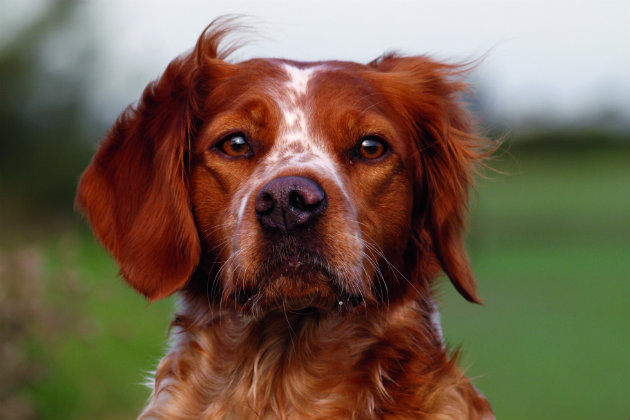French gundogs – why don’t we see more of them here?
Britain an France share a common love of fieldsports but very few Gallic gundog breeds cross the Channel. David Tomlinson asks why.

A Brittany
Some French gundogs
- L’épagneul Breton, the Brittany
- L’épagneul Français (French spaniel)
- Barbet
- Braque d’Auvergne
- L’épagneul de Pont-Audemer
- Braque de Bourbonnais
- Braque Français

A braque d’Auvergne; one type of braque Francais
Why French shooting is different
The French are every bit as passionate about fieldsports as we are, possibly even more so, but when it comes to shooting they go about it in a markedly different way and French gundogs are different too. There are driven pheasant shoots in France, but they are few in number. When Harold Macmillan shot in France as a guest of General Charles de Gaulle, our Prime Minister was reportedly unimpressed with the low-flying birds.
French shooting is traditionally a highly social affair, where the pursuit, not to mention the lunch, is far more important than the size of the bag. The French word for hunting, la chasse, says it all, for the chase is what it is all about. Most shoots are community affairs, meeting every Sunday during the season. The shooting is largely walked-up, so by far the most popular dogs are HPRs or setters. The French are a nation of dog lovers, so a shoot will often include a variety of non-sporting dogs, some simply accompanying their masters for the exercise rather than the sport.
View this post on Instagram
Gundog training in France
My experience suggests that, generally speaking, the French do not try to train their dogs to the same standard as we do. This is not to say that there aren’t some excellent handlers and beautifully trained French gundogs, but the majority of French chasseurs are more interested in shooting than dog work and they tend to rely on their dogs’ instinct rather than their training. Dogs that are accomplished retrievers are in the minority. I once spent a day on a shoot in the south of France hoping to get photographs of the dogs picking-up. Alas, no birds were retrieved.
I spent another day with a gun pack in the foothills of the Pyrenees. The majority of the pack dogs were beagles, joined by several terriers and a couple of large, long-eared hounds. The quarry was roe and boar but, despite plenty of shooting and covering a considerable amount of ground, nothing was bagged. However, it was a memorable day’s sport in wonderfully scenic country.
Several beagles were missing at the end of the day but nobody was concerned. A van was left overnight with its back door open for the hounds and they duly returned. In researching this article, I tried to find out how many French gundogs are described in breeds have, but the problem was precisely defining a gundog. Should the hound-like dogs that are often employed in gun packs be included?
I gave up in the end, but concluded that the French have considerably more breeds than we do, which may seem surprising as so few of them have ever been imported into the UK. France is a big country and there are many rare breeds that are seldom seen away from the areas where they originate.

A Korthals Griffon – not French, but Dutch
Import mystery
Why so few French gundog breeds have been established in the UK is a mystery, especially when compared with the number that we have imported from Germany.
The best-known French breed here is l’épagneul Breton, the Brittany. Now, épagneul translates from French to English as spaniel, but we no longer call it that. The name was shortened to Brittany because it was thought that the addition of the word spaniel was confusing.
As a hunting dog, the Brittany is a classic HPR, hunting widely and pointing its quarry, so not a spaniel as we know it. Many Brittanys aren’t great retrievers, which makes them popular with falconers.
If you can’t name another French gundog, it’s not surprising. One that almost qualifies is the Korthals griffon, for the French have adopted this Dutch breed as if it was their own and there are far more of them in France than anywhere else. Though they were first imported into the UK about 20 years ago, they have acquired their own keen following.
If you have ever fancied a pointing springer then l’épagneul Français (French spaniel) is the dog for you. Its appearance is that of a large liver-and-white English springer. There’s now a small nucleus of working dogs established in the UK, though the stock came, ironically, from Canada not France. The relaxation of the quarantine laws at the start of the century led to a number of other French breeds being imported. One of the most distinctive is the barbet, a French chien d’eau, or a curly-coated water dog. Think of it as the French equivalent of an Irish water spaniel.
https://www.instagram.com/p/CGwuqngBGLO/?utm_source=ig_web_copy_link
Handsome breed
The barbet remains a rarity in the UK, as is the handsome braque d’Auvergne, but both breeds are now established here. The latter is a large, hound-like HPR and one bred for the field rather than the show bench.
The same is true of l’épagneul de Pont-Audemer, another curly-coated water dog and a recent import. If the pet passport scheme continues to allow the free passage of dogs between France and England we might well see the import of the hound-like braque de Bourbonnais, perhaps even braque Français, which has claim to be the oldest breed of pointer in the world.
However, I believe that French gundogs have a similarity with French cheeses: they are to be enjoyed at their best in their country of origin.








